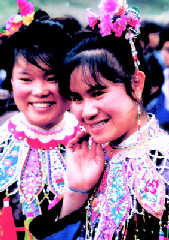 Nestling among the tree-clad hills dotting an extensive stretch of territory on the Hunan-Guizhou-Guangxi borders are innumerable villages in which dwell the Dong people. The population of this ethnic minority in China is 2.5 million (by 1999).
Nestling among the tree-clad hills dotting an extensive stretch of territory on the Hunan-Guizhou-Guangxi borders are innumerable villages in which dwell the Dong people. The population of this ethnic minority in China is 2.5 million (by 1999).
With no written script of their own before 1949, many Dongs learned to read and write in Chinese. Philologists sent by the central government helped work out a Dong written language on the basis of Latin alphabet in 1958.
The Dong ethnic minority originated from one branch of the Bai Yue people in ancient China. During the Qin and Han dynasties (221BC-220AD), this branch was named Luo Yue, and later changed into Liao. Ancient documents recorded that the Dong people was once named the Dong, Dongman, Geling and Dongliao, etc. It was after the nation's liberation that its name was finally settled down as the Dong ethnic minority.
Farming is the major occupation of the Dongs, who grow rice, wheat, millet, maize and sweet potatoes. The most favorite trees of the Dong are fir and oil-tea camellia trees. Serving the guests with oil-tea is the traditional hospitality of the Dong people.
Since ancient times, the Dong has worshipped both Gods and Ghosts. Under the influence of the Han culture, some of the Dongs have converted to Buddhism.
Many popular legends and poems, covering a wide spectrum of themes, have been handed down by the Dongs from generation to generation. Their lyrics tend to be very enthusiastic, while narrative poems are subtle and indirect, allusive and profound. Songs and dances are important aspects of Dong community life. The Dongs have many festivals -- Spring Festival, Ox Worshipping Festival, New Harvest Festival, Qingming Festival and Dragon Boat Festival, etc.
Equally spectacular is folk architecture. Their houses, built of fir wood, are usually two or three stories high and stand on stilts, located on steep slopes or riverbanks; people live on the upper floors, and the ground floor is reserved for domestic animals and firewood. The roofed bridges which the Dongs have dubbed "Wind and Rain" bridges are best-known for their unique architectural style. The Chengyang Wind and Rain Bridge in Sanjiang is 165 meters long, 10 meters across and 10 to 20 meters above the water. Roofed with tiles engraved with flowers, it has on its sides five large pagoda-like, multi-tier pavilions beautifully decorated with carvings. The Mapang Drum Tower especially elaborate; standing 13 stories high, it is decorated with carved dragons, phoenixes, flowers and birds.
